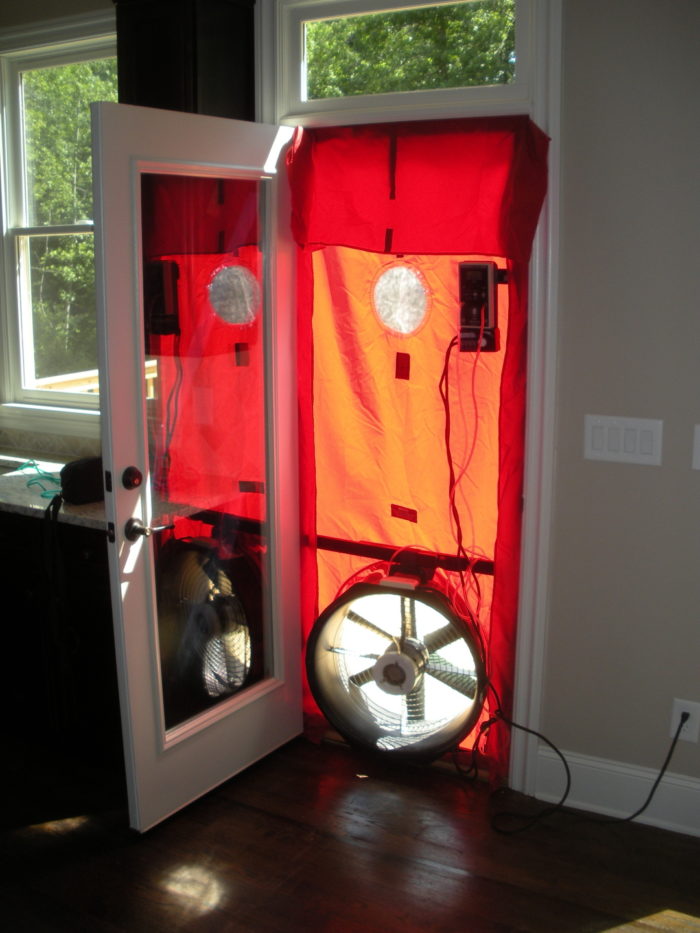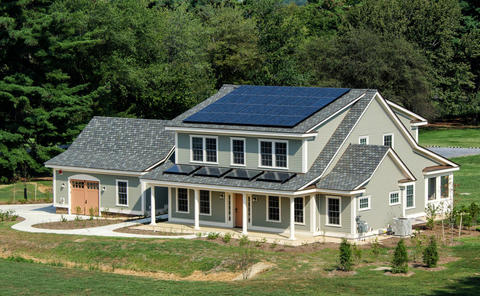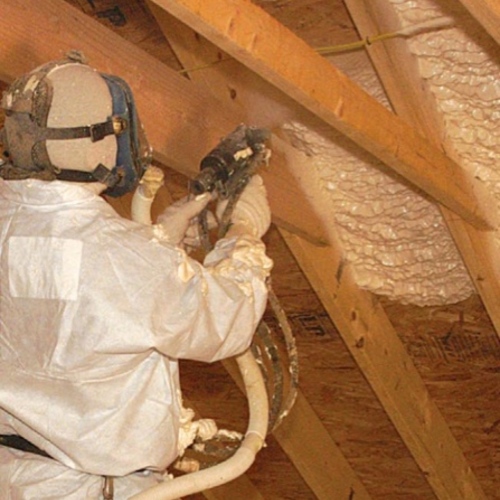Image Credit: Carl Seville
Image Credit: Carl Seville Fairmount Townhomes is a set of affordable town homes that are seeking LEED certification. It's an interesting project, but it would have been nice to come in much earlier in the process.
After several months off from my blog, I am finally inspired to start writing again. I clearly don’t have the stamina of Allison Bailes of Energy Vanguard, who seems to put up a blog post about every 10 minutes, but I do need to get back on track so I don’t fade into obscurity (if I haven’t already).
Over those many moons I have done some contract writing for the USGBC on the LEED for Homes Version 4 Reference Guide, completed the Georgia energy code required Duct and Envelope Testing on countless new homes, given presentations in Colorado, Baltimore, Greenville, and Atlanta, had three new minisplit HVAC units installed in my house, certified single and multifamily buildings under different green programs, and done some general green consulting for owners and builders.
Too little too late
It’s this last portion of my work that brings me the most frustration. Too often I am called in to help make projects “green” far to late in the design process. Plans are done, sometimes construction has even started, and suddenly someone decides they want their home to be green.
There is a huge gap in understanding of what it takes to make a green building. Too many people, many of them otherwise knowledgeable design and construction professionals, believe that they can take any design and successfully “green it up” after the fact.
When this happens, buildings can be made better, but in almost every case, decisions are made that compromise the quality of the building that cannot be changed without significant expense, if at all. HVAC equipment is located in unconditioned space. Unshaded glazing leads to overheating, larger HVAC systems, and higher energy bills. Bathrooms, kitchens, and water heaters are spread out to create the least efficient hot water distribution system possible, leading to water and energy waste, as well as owner inconvenience.
Whether it is another stock design that is being placed on a lot with no consideration for solar orientation or a custom design, in almost all cases, little if any consideration has been given to sustainable design and construction early enough in the design.
What will it take?
What will it take to get people — owners, architects, and contractors, at least those who want to build green — to start thinking green from the very start?
As green professionals, we know the value of making the right decisions early. Buildings work better, last longer, energy bills are lower, and in many cases initial construction costs are reduced. There is no downside to starting early, other than perhaps having to actually think a little differently.
Many people fear change, but those who are willing to accept the challenge will end up with better projects at lower cost, provided they take the time to plan properly. How can we learn to explain this clearly enough to the rest of the industry to get them to start thinking green earlier in their planning? I wish I had the answer.
In the meantime, I will keep plugging along, pushing the wet noodle of the construction industry towards making buildings better.
Weekly Newsletter
Get building science and energy efficiency advice, plus special offers, in your inbox.
















8 Comments
Energy Efficiency and Building Codes
Carl,
If wholesale change comes in the way we build it will have to be code driven. The live for today attitude is stronger than ever, why invest in the future when we can live larger today. I hope 2012 IECC is taken seriously as it is a good start towards raising the efficiency bar.
same deal in commercial/institutional "green" buildings
Carl,
I've worked as a commissioning agent and sustainability consultant on non-residential projects, and we typically have exactly the same problem. It is the rare exception that we are brought in during the design phase, when we can actually have a significant impact on the end result. More often, we're brought after the design is complete; at that point, there is little we can do to improve the building and the process devolves into one of putting green lipstick on a pig of a project.
I share your frustration, and your question: How can we lead people to understand that real green building starts at the concept phase? I don't know the answer, but I think I have identified the mental stumbling block that encourages this error: people think of green attributes as "features", like a granite countertop or a more-efficient AC unit. Manufacturers encourage this perception, because it drives people to buy all kinds of green amenities.
The reality is that you cannot get to green by substituting money for careful and considered design. I think this is the reality that must be impressed on people's thinking, but there are powerful economic forces arrayed against this understanding.
@Doug: I actually disagree with you about the centrality of codes. We do a lot of code work in our office, and while it is useful it is hardly a full solution. Codes require enforcement to be meaningful, and if the AHJ is overwhelmed or apathetic or simply confused, the codes will have no impact.
Energy codes in particular are problematic, because they almost always rely on energy models. Energy models are useful tools when deployed in a sincere attempt to learn how a building will perform, but they are easily distorted and gamed when they are deployed as a means of keeping score. If there is an incentive to make the model look better than reality, it is not hard to do so.
Gaming the code official
Brent,
Some folks cheat for a living, that will not change. I say the basic improvement in building efficiency will be by way of improved energy codes. No more voluntary compliance, build better or take up another profession. It happened here in Minnesota when the energy code was updated in the early 2000's. We do build more airtight on average here than most other states, the code calls for a continuous air barrier. In approving the stronger energy code, the state gave code officials the power to enforce the new guidelines. It worked here, it takes commitment from all parties to put changes in place.
Great questions!
Carl, I think you have me confused with Llloyd Alter. He's Mr. Prolific in the blogging world, writing 3 or 4 or more articles a day. Great questions, though. If we could figure out how to get people to do this stuff from the very beginning, we'd be a lot further along.
Education, planning & design -then build?!
Hey...we are putting in the carpet tomorrow can you come give a us a green certification? Or - we just hung the sheetrock - can you help us make this house more energy efficient? Leaders lead, and sheep follow!
We are never ending trying to drive home that education, planning and design are the first steps. Unfortunately they think finding a plan close to the ones that are selling this moment is the first step.
BTY -I think Allison must have figured out how to make a buck off blogging?
Back to education
Brent said:
"I don't know the answer, but I think I have identified the mental stumbling block that encourages this error: people think of green attributes as "features", like a granite countertop or a more-efficient AC unit. Manufacturers encourage this perception, because it drives people to buy all kinds of green amenities.
"The reality is that you cannot get to green by substituting money for careful and considered design. I think this is the reality that must be impressed on people's thinking, but there are powerful economic forces arrayed against this understanding."
So it's back to the education of the educators -- the people who run and professor at architecture schools. Architects design aspirational buildings -- you don't download "dream" projects from a site that hawks builders' plans.
If architects communicate "efficient design" as a basic quality in commercial/institutional/residential buildings, then consumers at the mass level will be driven to copycat the 'latest and greatest.'
When "green" becomes: "That's just how it's done in a modern building," that'll be the day when builders and codes will standardize efficient practices.
The Code Solution
To Doug McEvers,
It sounds like Minnesota may have implemented a stricter prescriptive energy code that works. But I think building green is still a discipline where increased regulation can be dangerous. There are lots of reasons:
1. The technology is still changing too fast - a prescriptive requirement that seems reasonable today might not make sense in a year or two, but it will increase cost.
2. Misinterpretation by code officials who don't really understand the intent.
3. Unintended consequences. We've seen this only too often, when a code requirement causes an unforseen problem with the building that doesn't even show itself for years. (interior poly vapor barrier used in the South on a brick building)
The classic example is the marginal cost /benefit for increased insulation compared to PV. As PV gets cheaper and more efficient, dollars spent on PV achieve greater savings than dollars spent on increased insulation. The code people cannot be expected to know when this happens.
So if the code has to be the solution, it should be a performance code. For example, if you can build and commission a zero energy house, you can build it any way you want that also complies with the existing safety codes.
Freedom and Liberty from building codes
To Kevin Dickson,
The changes Minnesota made to the building/energy code mainly dealt with the air barrier and ventilation. You can comply in anyway you want (poly, ADA) to form a continuous air barrier, just do it. Minimum ventilation standards make sense in all buildings. MN was carefull to balance code changes so the new requirements led to safe buildings. We now have a good code foundation that will make implementation of future code upgrades easier.
Log in or create an account to post a comment.
Sign up Log in